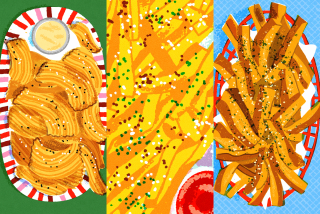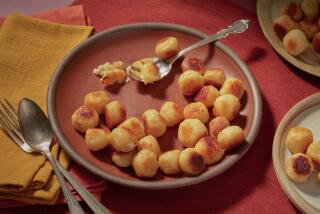The Report From Potatoland : Adventure: The Indiana Jones of the potato world explores the Andes in search of a spud.
- Share via
WASHINGTON — Carlos Ochoa is the Indiana Jones of the potato world. Exploring the harsh Andean mountainsides since 1950, the Peruvian taxonomist has discovered and documented more than 70 species of wild potatoes.
“The Andes are very tough. You have to be in good physical condition. You have to have good eyes. You acquire certain instincts. You smell. And when you find . . . it’s a gift for the spirit,” Ochoa said.
His potato expeditions have taken him to a snow-capped peak that would later spew volcanic ash over the plants, and to the South American island that inspired Daniel Defoe to write “Robinson Crusoe.”
Ochoa recently embarked on a far more modest journey, an all-potato symposium at the Smithsonian Institution where he joined 70 international scientists, researchers and policy-makers who have devoted their lives to the tuber.
The symposium was sponsored jointly by the Smithsonian Museum of Natural History and the International Potato Center (CIP) in Lima, Peru, a scientific institution where Ochoa’s wild-potato plants are stored.
Norio Yamamoto, an ethnobotanist at the National Museum of Ethnology in Osaka, Japan, spoke about the mythical potato in traditional society. Yamamoto spent several years in the Central Andes studying the agricultural practices of potato farmers, who snack on potatoes in the fields as they are harvested. (They bake them with the hot ashes from burning mountain grasses.)
John Niederhauser, now a professor of plant pathology at the University of Arizona at Tucson, spent his career helping other countries make the potato more productive. He just won the World Food Prize for his contributions.
Niederhauser, who lived in Mexico for 35 years, helped that country develop potato varieties resistant to the fungus that causes late blight, the disease responsible for the Irish potato famine. The Mexicans have plans to provide leadership to grow these varieties internationally, Niederhauser said.
Richard Sawyer, director general of CIP, who gave up a potential career in small fruits to found the research center with the world’s largest potato-germ-plasm bank, kicked off the symposium with a rousing potato pep rally.
Calling it the most important diversification crop for countries with rice self-sufficiency, Sawyer declared that the potato produces more calories and high-quality protein per hectare (2 1/2 acres) per day than any other major plant food.
While the conference focused on the potato as the potential answer to world hunger, the promises of biotechnology and the minimization of pesticides, participants discussed the historical, cultural and culinary aspects of the tuber as well.
The cradle of the potato is the Andes, where Peruvian Indians first raised them more than 5,000 years ago. The Indians were ingenious cooks, learning how to dehydrate potatoes so that they could be stored for future use.
Still practiced today by Andean villagers, the ancient method consists of spreading the potatoes on the ground in the cold night air, followed by several days in the sun. Villagers then stomp on them to squeeze out the moisture that the freezing night air and hot sun have not already eliminated. The result is called chuno.
By providing a secure food supply, the potato has enabled civilizations to occupy themselves with other things. With self-sufficiency in food secure, the Incas were able to conquer much of South America, said Rhoades.
The Indians’ potato know-how would come back to haunt them, however; almost 80 years after the Incas were conquered by Spain, Spaniards were still living off their warehoused dried potatoes.
Many scholars also link the beginning of the Industrial Revolution to the widespread production of potatoes in Europe, said Robert Mercer, president of the National Potato Promotion Board.
A readily grown crop eased the time and energy needed to feed the population. That energy was then redirected toward other pursuits, namely industry and technology.
Before it would gain widespread appeal in Europe, the potato went through tough times. First introduced by the Spaniards in 1570, Europeans thought it caused syphilis, leprosy, rickets and consumption. In fact, some of the English were so adamantly opposed to it that they wanted to ban it from the country.
Guilt by association was the cause of much of this discrimination, according to Rhoades. The potato belongs to the botanical family that includes hallucinogenic and narcotic cousins such as mandrake and nightshade.
The poisons in these plants were used to prepare ointments strong enough to give “witches the power to fly,” Rhoades wrote in an article for National Geographic in 1982. Europeans wanted nothing to do with it.
Gradually, the Europeans eased up, and the potato was introduced to North America in 1621, when the governor of the English-controlled Bahamas sent two boxes of potatoes and other vegetables as a gift to the governor of Virginia.
Nowadays the potato is grown in 130 countries, and there are efforts by Americans to cover the world with processed spuds. That’s why children are the target for the National Potato Promotion Board’s efforts to spread “American fries” to the Orient. “Their taste buds haven’t been trained to like sushi yet,” said Robert Mercer, president of the board.
With fast-food restaurants, the growth of French fries in Japan has already boomed, from 25,000 metric tons in 1980 to more than 100,000 metric tons in 1988.
And with the help of money from processors and the U.S. Department of Agriculture, the potato board opened an office in Tokyo and began an all-out blitz. On one day, for example, it bought the entire ad space of the largest newspaper in Japan to promote American fries. It offered cooking lessons to Japanese brides and happily welcomed the opening of a bar in Tokyo that features American fries.
But children have “made our marketing easy,” said Mercer. “Kids worldwide love the taste of fries.”
When asked whether selling high-fat fried potatoes to children in countries characterized by low-fat diets might help set up a whole generation of heart-disease victims, Mercer replied, “It’s true we’re adding oil.” But “it’s strictly a business,” he continued. “We could give up all that money too.”
A panel of presidents from four international potato associations addressed the issue of “global potato-research needs,” which highlighted the stark differences between the needs of the industrialized and developing worlds.
For the Potato Assn. of America and the European Assn. for Potato Research, top priorities include reduced use of pesticides in potato production. In the developed world, potatoes are the second highest user of pesticides, one speaker noted. Yet developing countries can barely afford chemicals.
For the Latin American Potato Assn., where average potato yields are less than half those in developed countries, the focus is on research to improve yields and breed disease-resistant varieties. But there’s even a shortage of scientists.
In Africa, increases in potato production during the last 20 years are due almost solely to increases in acreage--not improvements in yield.
Production increased by 121%, and acreage rose by 112%; yields improved by only 4%, according to Mahmoud Azzouz, president of the African Potato Assn. Basic breeding research to identify varieties best suited for African climates is still needed.
Other potato facts:
--Blue potatoes, grown in California and Michigan and sold in specialty stores, are sometimes referred to as “Peruvian potatoes,” according to Mercer. Nevertheless, the seed stock came from England.
--Before making the recent switch to 100% vegetable oil, McDonald’s used 40% beef tallow and 60% soybean oil to fry its French fries, Mercer said.
--Dell Raybould, an Idaho potato farmer, has developed a French fry that absorbs 50% less oil than traditional fries. It’s shaped like a Vienna sausage, but something about its texture makes it absorb less oil, according to Raybould, who wouldn’t divulge any more.
According to CIP, the world is using only 10% of the wild-potato species available to help solve varietal adaption and pest and disease concerns.
Part of the problem is that it takes a long time to introduce, select and establish a particular trait, and often the most desired traits are the hardest to achieve. In addition, new pathogens can eventually overcome resistant varieties, according to a paper distributed at the symposium.
Most of the potatoes grown in the United States come from only six varieties. In fact, according to John Dodds of CIP, American potatoes are “lousy” in terms of disease resistance, since the varieties developed here have been bred primarily for good processing traits.
At a reception held at the Museum of Natural History, the only tuber nibble was halved new potatoes with melted Cheddar.
Chatting over chicken salad and crackers, Marjorie Leon, senior computational linguist at the Pan American Health Organization, described the many potato dishes she ate while living in Peru for 12 years.
She learned to prepare papa a la huacaina, boiled yellow potatoes covered with a sauce of garlic, cheese, hot yellow peppers, milk and bread crumbs and garnished with black olives; causa a la limena, mashed potatoes layered with tuna fish, and papa rellenos, riced potatoes mixed with ground beef, raisins, olives and onions and fried in oil.
She misses the different kinds of potatoes available in Peru, including papa amarilla, a yellow potato that “tastes almost as if it had butter and salt already on it.”
More to Read
Sign up for Essential California
The most important California stories and recommendations in your inbox every morning.
You may occasionally receive promotional content from the Los Angeles Times.













